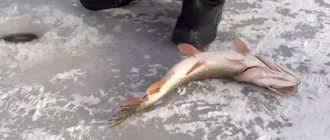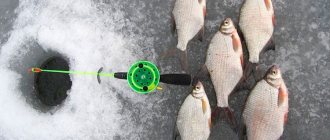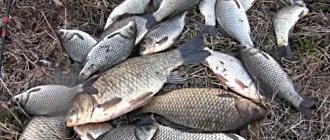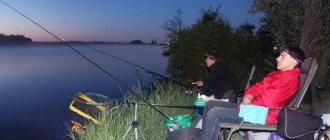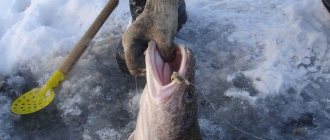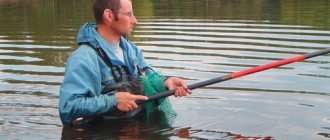Orekhov A. | December 15, 2005
When winter is in no hurry to take over, and autumn, on the contrary, is in no hurry to leave, incomprehensible weather causes a lot of troubles and inconveniences. Frost alternates with rain and above-zero temperatures, then a blizzard falls on our heads, which again gives way to a thaw. Everything that happens in nature causes frustration and irritation for most people, including fishing enthusiasts. However, each weather has its own fish, which are best caught precisely in these weather conditions, and the favorite of the slushy late autumn and early winter is burbot.
Freshwater cod
This fish is the only representative of the cod family that lives in fresh water. In fact, burbot is a great original; this fish is most active in cold water - provided, of course, there is a sufficient amount of oxygen dissolved in it. If in the south of Russia there is little burbot, and in the middle zone it rarely grows to a kilogram of live weight, then in the basins of northern rivers it is also found in gigantic sizes.
In the “Atlas-Identifier of Fish” by N. A. Myagkov it is indicated that burbot reaches a body length of about 1 m and a weight of up to 20 kg (usually 60-80 cm and 5-8 kg). According to A.V. Neelov, in the Lake Ladoga basin the largest burbot was caught in 1910 and weighed 16 kg, and V.B. Sabunaev claims that specimens weighing about 30 kg were caught in the Ob. Over many years of hunting freshwater cod, I was content with specimens up to one and a half kilograms. Burbot is a nocturnal predator that feeds on small fish, mollusks, crustaceans and insect larvae; it does not disdain carrion. Burbot begins to actively feed with the autumn cooling; the greatest feeding is observed in December - early January. The spawning that follows the zhor occurs in the second half of January - February, then this fish can be found in shallow water with a rocky, pebble or sandy bottom. In March - April, burbot begins to actively feed again. Another feature of burbot, confirmed by numerous observations, is that the most active bite is observed, as a rule, in bad weather, on stormy nights, and with a clear and full moon it weakens.
An important point when fishing is the correct choice of place. Burbot stays exclusively near the bottom. During daylight hours, it usually hides in “strong” places in the reservoir: under snags, between washed-out tree roots, among stones and sunken logs, in holes and under steep ledges of the bottom, next to bridge supports and piers. When darkness falls, he comes out of hiding and goes hunting. At the same time, according to ichthyologists, burbot moves along the same underwater paths - for example, adhering to grooves on the bottom - and moves towards those places where the aquatic life on which it feeds accumulates. Therefore, it is advisable to calculate in advance the likely migration routes of burbot, and if successful, remember the favorable place and its characteristic features. In the spring, as the water warms up, burbot either goes to great depths or hides under stones, snags, or in holes under the banks. In summer, the palim is least active and practically does not feed.
The influence of atmospheric pressure on biting in winter
In winter, the illumination factor is less important for reservoirs, since the illumination is evenly smoothed out by a layer of snow. Fluctuations in temperature and waves (currents) of water equally become less fluctuating.
Thus, it is atmospheric pressure that becomes a more significant factor that determines the behavioral characteristics of the inhabitants of reservoirs.
There is a certain dependence between the quantitative characteristics of biting in winter and atmospheric pressure parameters.
In general, the most optimal period is when there are no significant pressure fluctuations for at least a couple of days; in such conditions, regardless of the variety, the bite is greatest.
Accordingly, the smallest bite is observed during fluctuations that last for a certain number of days.
The difference between the winter bite at high (that is, more than 760 mm) or low (that is, less than 744 mm) is not observed as such.
Although high pressure is more preferable in terms of further fluctuations, since, as a rule, it decreases smoothly (more favorable conditions) in contrast to low pressure, which can increase abruptly and fluctuate, that is, create not the most optimal fishing conditions.
On the donk
There are several ways to catch burbot; each is interesting and fascinating in its own way. In the fall, before freeze-up, it can be caught at night, using bottom fishing rods, using worms or live bait, including dead ones, as bait.
This fishing is extremely romantic. Having arrived at the place in the afternoon, it is necessary before dark, to prepare more firewood and arrange a place for the donks; it would not be superfluous to build a hut or put up a tent. It is most convenient to equip bottom fishing rods on spinning rods with spinning reels.
It is better to start fishing at dusk, having first lit a fire, which creates a unique comfort on a cold autumn night. And fighting in the dark with “beards” formed by tangled fishing line is a very futile task. It’s especially annoying when you have to do this during the bite.
Having cast the donks and attached bells to them (the most reliable indicator of a bite in the dark), all that remains is to wait patiently by the fire. There are different ways you can while away an autumn night, especially in company, but you should not just abuse alcohol. There have been cases when, after a significant amount of drink, “fishing organisms” lost orientation in space, which led to various undesirable effects, starting from banal falls into cold water and ending with “original” casting of bottom lead weights along the coastline, which are very dangerous for the health of neighbors. night fishing.
The burbot bite on the bottom tackle is expressed in the pulling of the fishing line, accompanied by the measured ringing of a bell. You should not rush into hooking - with an early jerk, you can simply pull the bait out of the mouth of the burbot, which swallows the prey not immediately, but gradually. But you shouldn’t delay it either - after having dinner, the burbot may well crawl under a stone or behind a snag, which will inevitably end in a “dead” hook. The correct timing of hooking is developed with experience.
Bait for burbot in December
If the equipment, in addition to reliability, is not so important, then the correct winter bait for burbot, as well as the search for points, determine success in fishing. You need to catch burbot in December using the same baits as always:
- Live bait.
- Dead fish.
- Pieces of fish.
- Frozen capelin, sprat or herring (not salted).
Burbot especially loves fatty fish - he will take a piece of whitefish, capelin or herring more readily than roach. The best live fish are loaches, bullheads, minnows, ruffes, and smelt. In each body of water, the slippery glutton has its own preferences, depending on the natural food fish. We place the fish or live bait on the hook of a jig, fishing rod or hook. The holes can be fed with leftover slices or minced fish. It can also take a bunch of worms - however, this is not serious, rather for places where there are no large predators.
Subscribe to the channel:
My YouTube channel RYBAFAN on fishing:
We're OK
To the wiring
Once I had the opportunity to catch burbot in the spring using a wire. It was in May, about 30 years ago. Taking with us worms and three-meter bamboo float rods, my friend and I went for roach to the dam of one of the reservoirs on the Karelian Isthmus. Below the earthen dam, the water flow from the sluice rushed along a long concrete trench approximately 5 meters wide. The depth there was 30-40 cm with a very strong current. All year round, especially in the spring, in this gutter or immediately behind it, at the confluence with a small river, a lot of fish accumulated, mainly roach, perch and ruff, which either rose to the dam from below, or rolled down from above from the reservoir.
Having attached dung worms to the hooks, we threw the tackle directly into the stream rushing along the gutter and began to wait for roach bites. At the very first hold, a confident bite followed - and, after hooking, on the shore instead of a roach there was... a hundred-gram burbot. We were surprised by this “miracle”, but continued fishing. Bites followed almost every hold, and only the same or slightly larger burbot was caught. But the largest specimen, which apparently rolled down from above, from the reservoir, weighed half a kilo. In an hour we must have caught the entire flock, which provided each of us with a very respectable catch for fourteen-year-old boys. When fishing, the burbots behaved very smartly, especially the larger ones. We had enormous pleasure, but in fairness, I note that this fishing turned out to be the only one of its kind so far. I have never been able to attack a flock of burbot in the spring again.
But the most productive burbot fishing occurs in winter. There are two ways to fish for this nocturnal predator from the ice: with special spoons, and with so-called “postavushki” (winter donks), or self-catchers.
Time and place of fishing
Burbot is active when the water cools to a temperature below 15ºC. At higher temperatures, fish are inactive, so fall fishing usually begins in October.
- The best time of day for fishing for burbot is night. The bite begins with the onset of evening twilight and ends at dawn. At this time, the predator leaves its parking areas and begins to search for places where it can profit from small fish, frogs, mollusks, etc.
- As soon as the first frosts arrive, the burbot's bite turns into zhor. During such periods, he goes to the coastal shallows to hunt for small fish. This is the best time to fish near land.
- When choosing a promising place, the fisherman should find out the characteristics of the bottom soil. Burbot does not like muddy bottoms, preferring sandy or rocky surfaces. For this reason, the most likely areas for successful fishing will be reaches and water areas with steep banks.
- The confluence points of streams and small rivers become quite attractive for cod, and sometimes the fish even enter these tributaries. Riffles, areas with reverse currents and whirlpools are subjected to careful examination. All these places need to be looked after during the day so that you can fully concentrate on fishing at night.
“Rattles” for burbot
Of course, burbot can be caught using ordinary winter lures. To increase efficiency, pieces of fish meat are placed on the hook, but this tackle is not strictly burbot, and it is not particularly catchy. Another thing is special artificial bait for catching this particular fish.
A widely known method of catching burbot is the so-called “snitch” or “ring”. There are many varieties of this gear. In one of the fishing magazines 2 or 3 years ago, V. Pervakov described a “snitch” that looked like a balance beam - perhaps one of the simplest designs. Based on that post, this is how I make my bait. From a sheet of annealed copper, brass or nickel 0.5-1 mm thick, I cut out a rectangular blank 60-80 mm long and 30-40 mm wide. Then I bend it in the middle to create a shape similar to a gable roof. If, say, the workpiece had a width of 40 mm, then in cross section you should get an isosceles triangle with sides of 20 mm and a base of about 20-25 mm. A hole is made in the middle of the workpiece to attach an eye made of thin wire, like a balance beam, and the scaffolding will be tied to it. Two single, fairly large hooks are attached to the wire tendrils of the eye - so that the rings and most of the forend are “under the ridge” of this very “gable roof”. The structure is then turned over and filled with lead. After filing and polishing (the easiest way is with a velvet brush with polishing paste), you get a product that can be described as follows: a triangular balancer without a tail unit and a lower tee (photo 1).
This gear is usually used before burbot spawning. The technique of fishing with it is simple: the “snitch” is lowered to the bottom, sharply raised by 10-20 cm, and then “thrown” down. Hitting the bottom, the “knock” makes a sound that attracts burbot, and to seduce it with the smell, pieces of fish are placed on the hooks. Although there is another assumption: the sound of the “squealing” not only attracts, but irritates the burbot, forcing it to attack the “aggressor”.
Sometimes a steel ring is attached to the eye (the easiest way is to use a winding ring). The meaning of this improvement is that, hitting the side surface of the “snitch”, the ring additionally produces sounds that also attract burbot. Then this tackle is called a “ring”.
The body shape of the “snitch” should not necessarily be triangular—maybe, for example, oval, cast in a mold. And there are not necessarily two hooks, but three or even four. Here the flight of fancy is not limited, and the correct design solution is determined experimentally. The main thing is to create more noise under water, and not just noise, but such that it provokes the burbot to bite. They are caught using a “snitch” (“ring”) on cloudy, stormy nights. To escape the winter cold, fishermen set up tents on the ice, which are heated from the inside either with their own heat, or with a candle, or an alcohol burner, or “Bumblebee”.
There is also a bait, the principle of which is similar to the “snitch”. It is made from two heavy oscillating spinners - for example, the Norich type. Both spinners are attached to a common winding ring; a carabiner is attached to it, to which the scaffolding is tied. There is only one trick: the spinners must be secured so that their convex parts touch (photo 2). The resulting “rattle” is lowered to the bottom, then raised a few centimeters - and either thrown down like a “snitch” or shaken at the very bottom, again creating sounds that attract burbot. Another subtlety: if you leave tees on both spoons, they will very often cling to each other and disrupt the “game” of this tackle. There are several ways to combat this phenomenon, the simplest of which is to remove one of the tees. You can also install small tees so that they do not “reach” each other, or use single hooks instead of tees.
No matter how sporty
Both at the beginning of winter and in the spring after spawning, burbot is caught from the ice using so-called “postavushki” (winter donks), or “samolovs”. This tackle is not considered sporting; There is certainly some truth in this; however, winter burbot donks are very popular - perhaps, by the way, also because elements of excitement and sportiness are still present in this method of catching freshwater cod.
Winter donks have a basic design (photo 3). Several meters of fishing line are wound onto the reel - based on the depth of the place where fishing will take place. The length of the fishing line should be 2-4 m greater than the maximum possible depth, the diameter of the fishing line should be 0.3-0.4 mm. A fairly heavy weight is attached to the free end of the line - for example, if you are fishing in a river, it should not be carried away by the current, holding the bait in place. A leash about 500 mm long made of 0.25-0.28 mm fishing line is tied to the load or slightly higher. A large hook for predatory fish is installed on the leash. For bait they take either small fish, including dead fish, or pieces of fish meat. It is best to use bait caught here; its species composition is standard: ruff, perch, roach. On Lake Ladoga it is very good to catch small smelt.
On the shore you need to prepare rods according to the number of donks. For each donkey, a hole is drilled, the baited tackle is lowered into it, which is attached with a simple noose to a rod placed across the hole. The reels are placed in the snow next to the hole, but under no circumstances in the water. The load lies on the bottom, the free movement of the fishing line should be about one meter. Donks are installed in the afternoon and checked the next morning. If snowfall is expected, it is advisable to mark the holes with additional rods stuck nearby - otherwise you may be left without fish and without gear. By the way, there was a case when a donk, placed before a snowstorm in January, was found only in March, after the last ice. On the hook sat an emaciated, dystrophic fish more than half a meter long and weighing only 500 g. The unfortunate burbot resembled a prisoner of a concentration camp - with skin stretched over numerous ribs so that they could easily be counted. Dangling on the fishing line for more than two months, he, like a chained dog, scared away all the small fish in the area.
If there is a strong frost at night and the holes are very frozen, then the donuts are removed in the following way. Next to the frozen hole, another one is drilled. The fishing line is taken out of the new hole using a wire hook. Then the rest of the line is unwound from the reel and pulled through the ice. If the night frost was not severe, then the ice crust formed in the hole is simply broken with a scoop.
The above-described method of catching burbot can be modified by using smelt fishing rods instead of “deaf” donks. But in this case, in addition to the moral readiness to sit on the ice all night, it is necessary to solve the problem of lighting the bottoms - in order to see bites in the dark. True, in the spring you can fish with such gear during the day, you just need to know where the burbot gathers in schools and feeds intensively. This is how they catch, for example, in the Priozersk area on Lake Ladoga.
Atmosphere pressure
As the name implies, this parameter indicates the pressure of the atmosphere, in particular the pressure on what is located under the atmosphere.
Atmospheric pressure can change over time and depending on the area of measurement, which is usually performed with a barometer, which defines a mercury column pressure of 760 millimeters at zero temperature as normal.
Low atmospheric pressure and fishing
In order to determine low pressure, it is not at all necessary to use a barometer; it is possible to use indirect signs.
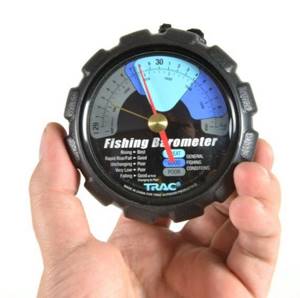
In particular, smoke from a fire, which at low pressure dissipates little and spreads low (easy to remember: low pressure - low smoke) and foam, which accumulates near the shore.
In general, low pressure reduces fish activity, and if there is a sharp decrease, then you should not expect a bite. This change results in a significant reduction in fish activity.
However, with low pressure, which decreases smoothly or steadily over a certain period, it is possible to obtain very high results, in particular when catching predators.
The point here is to reduce the activity of non-predatory inhabitants of the water, which descend lower and begin to move less, accordingly, predators try to take advantage of this, that is, they quite actively peck at the bait.
In low pressure conditions, it is effective to try different methods of catching pike and pike perch, burbot and perch, and the opportunity to catch catfish increases.
Increased atmospheric pressure and fishing
High atmospheric pressure causes approximately the opposite picture in water bodies: predators reduce their own activity and fish that consume vegetation become more active.
However, high pressure, as well as changes in this parameter in general, do not affect the behavior of pike perch and even young perches are active in conditions of high pressure.
Otherwise, you should pay attention to fishing on the surface of such species as:
- roach;
- bream;
- silver bream;
- ide;
- chub;
- carp.
They move to the upper layers of water, become more active in search of food and may be interested in a variety of baits. Of course, for each individual variety, the methods that are optimal for them should be used.
